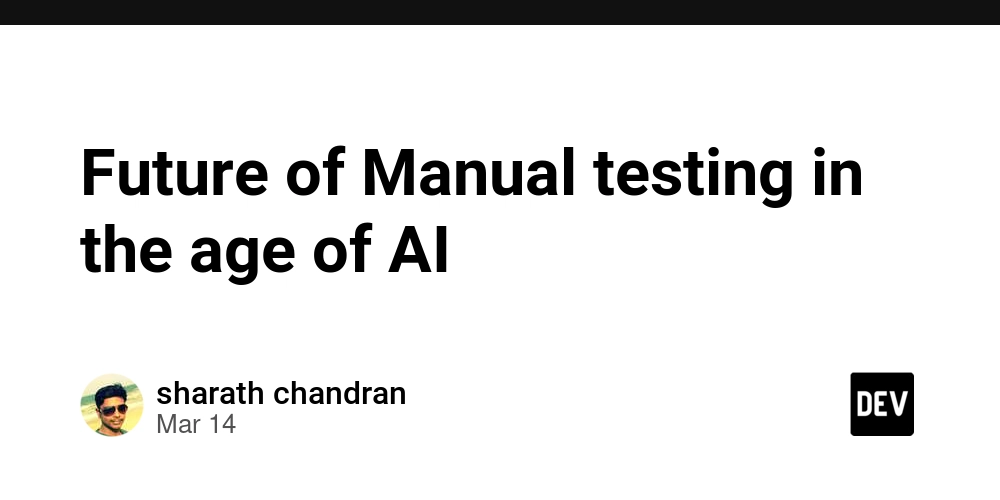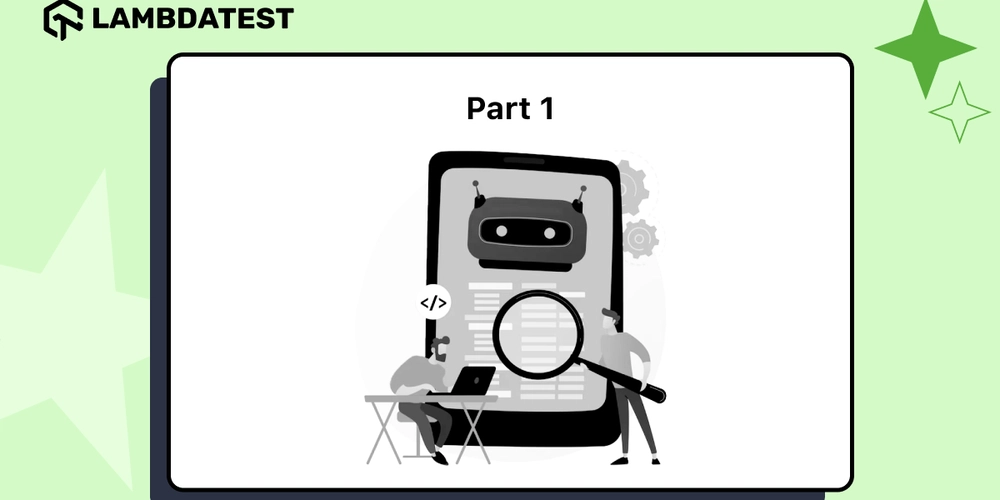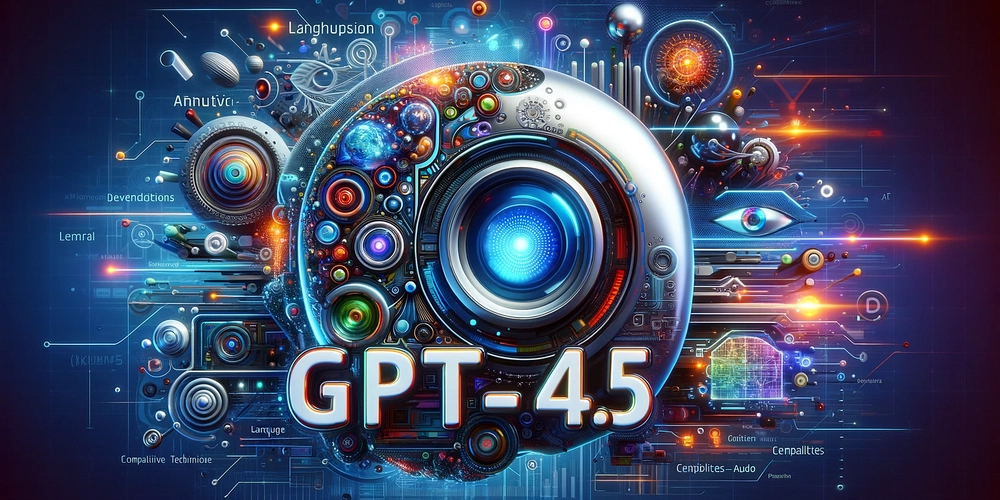Future of Manual testing in the age of AI
As artificial intelligence (AI) continues to transform industries, the role of manual testing in software development is undergoing significant change. While AI-driven automation tools are becoming increasingly capable, manual testing will not become obsolete. Instead, its role will evolve, with testers adapting to new responsibilities that complement AI technologies. The future of manual testing lies in a hybrid approach where AI and human expertise work together to enhance software quality and testing efficiency. 1. AI-Powered Automation AI has revolutionized the automation landscape, making it easier to perform routine tasks such as regression testing, data handling, and large-scale test execution. Advanced AI tools can generate test scripts, adjust to changes in applications, and even detect issues automatically, allowing human testers to focus on more complex aspects. However, while AI excels at executing repetitive tests with high precision, it lacks the ability to evaluate certain critical aspects that require human judgment, such as user experience and usability. These areas will continue to rely on the creativity and intuition of manual testers. 2. The Shifting Role of Testers Manual testers will no longer be burdened with repetitive testing tasks, but instead, they will be expected to focus on higher-level activities. Exploratory testing, for example, will remain a human-dominated area where testers experiment with the system to uncover hidden bugs. Additionally, testers will play a key role in designing complex test scenarios that are difficult for AI to anticipate. With the growing reliance on AI, manual testers will need to broaden their skill sets, becoming familiar with AI tools and automated testing frameworks to remain relevant in this evolving landscape. 3. Optimizing Testing with AI AI is not only enhancing automation but also optimizing testing processes. By analyzing past testing patterns, AI tools can identify areas of an application most likely to have defects, allowing testers to focus their efforts where they are needed most. Furthermore, AI can help streamline the testing process by eliminating redundant tests and refining the test suite to ensure broader coverage with fewer resources. This enables manual testers to work more efficiently by targeting the most critical areas without wasting time on unnecessary tests. 4. Human Expertise in Exploratory Testing and UX Despite AI's growing capabilities, human testers will still be essential for tasks that require emotional intelligence and an understanding of real-world user interaction. Exploratory testing, which relies on creativity and intuition, is an area where AI tools fall short. Manual testers will continue to be the ones who simulate how end-users interact with an application, identifying unexpected issues and edge cases that automated tests may miss. In addition, evaluating the user experience (UX) will remain a human-driven activity, as AI cannot fully grasp the nuances of user emotions, satisfaction, and ease of use. 5. A Collaborative Approach The future of software testing will involve a synergy between AI and manual testers. AI will handle repetitive tasks and optimize testing processes, while human testers will focus on the critical tasks that demand creativity, human insight, and decision-making. Testers will increasingly take on the role of ensuring that AI tools are appropriately designed, calibrated, and aligned with testing objectives. This partnership between humans and AI will enhance the overall testing process, producing higher-quality, more reliable software. 6. Ethical Considerations As AI plays a larger role in testing, ethical concerns such as algorithmic bias and fairness will need to be addressed. Manual testers will be crucial in identifying and mitigating these biases, ensuring that AI systems function as intended and do not perpetuate unfair outcomes. The human touch remains vital in ensuring that AI-driven testing processes are conducted with sensitivity to context and inclusivity. Conclusion Rather than replacing manual testing, AI is augmenting it. The future will see testers and AI working in tandem, each complementing the other’s strengths. Manual testers will focus on tasks that require human insight, such as exploratory testing, UX evaluation, and complex scenario design, while AI will handle repetitive and resource-intensive tasks. This collaborative approach will result in more efficient testing and higher-quality software, ensuring that manual testing remains an essential part of the software development lifecycle in the age of AI.

As artificial intelligence (AI) continues to transform industries, the role of manual testing in software development is undergoing significant change. While AI-driven automation tools are becoming increasingly capable, manual testing will not become obsolete. Instead, its role will evolve, with testers adapting to new responsibilities that complement AI technologies. The future of manual testing lies in a hybrid approach where AI and human expertise work together to enhance software quality and testing efficiency.
1. AI-Powered Automation
AI has revolutionized the automation landscape, making it easier to perform routine tasks such as regression testing, data handling, and large-scale test execution. Advanced AI tools can generate test scripts, adjust to changes in applications, and even detect issues automatically, allowing human testers to focus on more complex aspects. However, while AI excels at executing repetitive tests with high precision, it lacks the ability to evaluate certain critical aspects that require human judgment, such as user experience and usability. These areas will continue to rely on the creativity and intuition of manual testers.
2. The Shifting Role of Testers
Manual testers will no longer be burdened with repetitive testing tasks, but instead, they will be expected to focus on higher-level activities. Exploratory testing, for example, will remain a human-dominated area where testers experiment with the system to uncover hidden bugs. Additionally, testers will play a key role in designing complex test scenarios that are difficult for AI to anticipate. With the growing reliance on AI, manual testers will need to broaden their skill sets, becoming familiar with AI tools and automated testing frameworks to remain relevant in this evolving landscape.
3. Optimizing Testing with AI
AI is not only enhancing automation but also optimizing testing processes. By analyzing past testing patterns, AI tools can identify areas of an application most likely to have defects, allowing testers to focus their efforts where they are needed most. Furthermore, AI can help streamline the testing process by eliminating redundant tests and refining the test suite to ensure broader coverage with fewer resources. This enables manual testers to work more efficiently by targeting the most critical areas without wasting time on unnecessary tests.
4. Human Expertise in Exploratory Testing and UX
Despite AI's growing capabilities, human testers will still be essential for tasks that require emotional intelligence and an understanding of real-world user interaction. Exploratory testing, which relies on creativity and intuition, is an area where AI tools fall short. Manual testers will continue to be the ones who simulate how end-users interact with an application, identifying unexpected issues and edge cases that automated tests may miss. In addition, evaluating the user experience (UX) will remain a human-driven activity, as AI cannot fully grasp the nuances of user emotions, satisfaction, and ease of use.
5. A Collaborative Approach
The future of software testing will involve a synergy between AI and manual testers. AI will handle repetitive tasks and optimize testing processes, while human testers will focus on the critical tasks that demand creativity, human insight, and decision-making. Testers will increasingly take on the role of ensuring that AI tools are appropriately designed, calibrated, and aligned with testing objectives. This partnership between humans and AI will enhance the overall testing process, producing higher-quality, more reliable software.
6. Ethical Considerations
As AI plays a larger role in testing, ethical concerns such as algorithmic bias and fairness will need to be addressed. Manual testers will be crucial in identifying and mitigating these biases, ensuring that AI systems function as intended and do not perpetuate unfair outcomes. The human touch remains vital in ensuring that AI-driven testing processes are conducted with sensitivity to context and inclusivity.
Conclusion
Rather than replacing manual testing, AI is augmenting it. The future will see testers and AI working in tandem, each complementing the other’s strengths. Manual testers will focus on tasks that require human insight, such as exploratory testing, UX evaluation, and complex scenario design, while AI will handle repetitive and resource-intensive tasks. This collaborative approach will result in more efficient testing and higher-quality software, ensuring that manual testing remains an essential part of the software development lifecycle in the age of AI.








































































































































































![[The AI Show Episode 143]: ChatGPT Revenue Surge, New AGI Timelines, Amazon’s AI Agent, Claude for Education, Model Context Protocol & LLMs Pass the Turing Test](https://www.marketingaiinstitute.com/hubfs/ep%20143%20cover.png)



































































































































![From drop-out to software architect with Jason Lengstorf [Podcast #167]](https://cdn.hashnode.com/res/hashnode/image/upload/v1743796461357/f3d19cd7-e6f5-4d7c-8bfc-eb974bc8da68.png?#)








































































































.jpg?#)
































_ArtemisDiana_Alamy.jpg?#)


 (1).webp?#)






































































-xl.jpg)











![Yes, the Gemini icon is now bigger and brighter on Android [U]](https://i0.wp.com/9to5google.com/wp-content/uploads/sites/4/2025/02/Gemini-on-Galaxy-S25.jpg?resize=1200%2C628&quality=82&strip=all&ssl=1)










![Apple Rushes Five Planes of iPhones to US Ahead of New Tariffs [Report]](https://www.iclarified.com/images/news/96967/96967/96967-640.jpg)
![Apple Vision Pro 2 Allegedly in Production Ahead of 2025 Launch [Rumor]](https://www.iclarified.com/images/news/96965/96965/96965-640.jpg)






































































































































